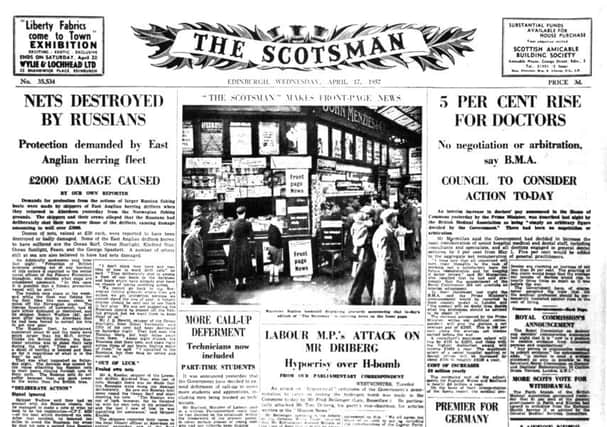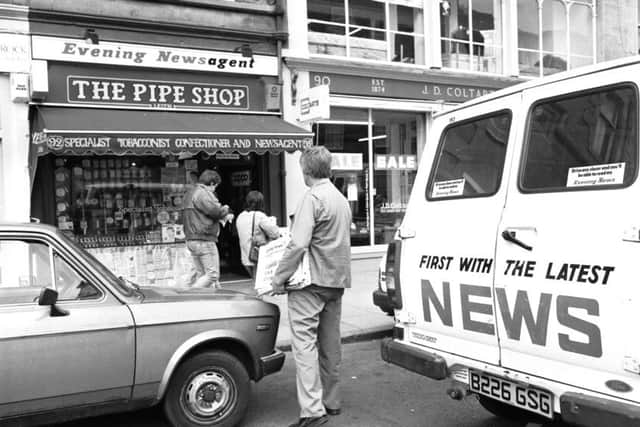The best Scottish newspaper headlines of all time


‘COUNTRY QUITE CALM - NO SCENES OF DISORDER’ (Emergency Press, 1926)
It’s not the catchiest headline ever printed but it illustrates one of the most remarkable episodes in the history of the Scottish press. May 1926 was a time of extraordinary social upheaval across the UK as a General Strike called by the TUC threatened to grind the country to a halt. Millions of workers - from factory staff to bus drivers - downed tools for nine days in an attempt to force the Government to prevent wage reduction and worsening conditions for coal miners. Members of the National Union of Journalists joined the action and many of the country’s newspapers were forced to temporarily halt production and leave news stands empty. The editor of the Glasgow Herald, the avowedly anti-socialist Sir Robert Bruce, was determined to defy the strike and the Emergency Press was the result. It was produced on behalf of six newspapers whose staff had walked out - the Glasgow Herald, Daily Record, Bulletin, Glasgow Evening News, Evening Times and Citizen - and took a firm pro-Government stance. Several unions, with the assistance of striking journalists, produced their own newspapers to counter it.
NETS DESTROYED BY RUSSIANS (The Scotsman, 1957)


Advertisement
Hide AdAdvertisement
Hide AdThis report from the depths of the Cold War told the story of a furious dispute between the fishing fleets of the UK and the Soviet Union - but it was where it was placed that made it something out of the ordinary. The first daily newspapers of the 18th century introduced a format of printing advertisements on the front page and saving reports for the inside. It was only in the mid-20th century that broadsheets abandoned this model, preferring to attract potential readers with their best stories on prominent display. The Scotsman switched to front page news in 1957. Several other titles, including many weeklies, persisted with the old format until the 1990s.
‘I DANCED WITH BIBLE JOHN’ (Daily Record, 1969)
A headline that remains attention-grabbing 47 years after it was printed. Bible John was the nickname given to a serial killer thought to be responsible for the murder of three women who had gone dancing at the Barrowland Ballroom in Glasgow. The killings took place between 1968 and 1969 and led to one of the largest police investigations ever seen in Scotland. The final victim, Helen Puttock, a mother of two, had gone out with her sister Jean and later shared a taxi home from the east end of the city with a man they met that night. Jean got out at Knightswood while her sister and the unidentified man continued on to Scotstoun. Helen was found dead the following morning. She had been raped and strangled. Jean’s eyewitness testimony of the likely killer described him as a well-spoken, polite individual who quoted passages from the Bible. It was this account that led to a series of dramatic reports in the press and an investigation that continues to generate headlines five decades later. Bible John has never been identified.
SCOTS ASSEMBLY, RIP (Glasgow Herald, 1979)


A simple headline can sometimes be the most effective. The Glasgow Herald’s splash of March 3, 1979, neatly summed up the end of a political dream - for a couple of decades, at least. Voters had been asked two days previously to vote whether or not they were in favour of the creation of a Scottish Assembly with limited powers. While a slim majority backed the plans, the infamous requirement that at least 40 per cent of the electoral roll vote yes put paid to the devolution dream. The political fall-out from the result led to a vote of no confidence in Jim Callaghan’s embattled Labour Government being passed by one vote, prompting a General Election and the dawn of Margaret Thatcher’s premiership.
MAKE IT A DOUBLE DEWAR’S (Daily Record, 1999)
May 6, 1999 was an historic day north of the border as voters went to the polls in the first Scottish Parliament elections. Twenty years after the failed assembly project, the new Labour Government fulfilled a pre-election pledge to establish a Scottish Parliament. The Daily Record cleverly linked the new two-vote system used for Holyrood elections with a well-known blend of whisky to endorse Donald Dewar as its choice for the country’s first First Minister.
SUPER CALEY GO BALLISTIC, CELTIC ARE ATROCIOUS (The Scottish Sun, 2000)
Writing a perfect tabloid headline is a skill that few master. Many of the best examples are to be found in the sports pages, where the combination of dramatic results and unexpected twists make for perfect stories. One such case was Celtic’s shock defeat to Inverness Caledonian Thistle in a Scottish Cup third round match. The Sun’s innovative choice of headline for its match report would create headlines itself. Although a fine example of wordplay, it wasn’t the first time Mary Poppins had helped make the news. Back in the 1970s, the Liverpool Echo ran the headline “Super Cally Goes Ballistic, QPR Atrocious.” The Cally in this case referred to Liverpool player Ian Callaghan.
‘I KICKED BURNING TERRORIST SO HARD I BROKE A TENDON IN MY FOOT’ (Daily Record, 2007)
Advertisement
Hide AdAdvertisement
Hide AdMany Scots will vividly recall the news that two terrorists had driven a Jeep packed with gas canisters into the main entrance of Glasgow Airport in a failed attempt to kill innocent people. The aftermath of the incident - in which several airport staff quickly moved to apprehend the perpetrators - made a global star of baggage handler John Smeaton. His cheerful but no-nonsene demeanour when giving interviews seemed to capture the mood of the country. But there were other tales of heroism from that day - and the Daily Record secured an exclusive by interviewing Glasgow taxi driver Alex McIlveen who had also bravely stepped in to tackle the terrorists.